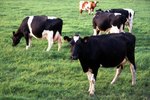
A cow's gestation period is approximately nine months. If know your cow's insemination date and the cow has calved before, there's a good chance she'll give birth after the same number of days as before. Aside from that, many physical clues can help you tell when birth is imminent. As your cow's calving date draws near, watch her carefully for these signs that she's about to calve.
Udder
Observing your pregnant cow's udder regularly gives you clues about when the birth might occur, but much depends on whether she's giving birth to her first calf or is an experienced mother. A udder of a first-time mother might start developing two months before birth, while that of the seasoned cow begins changing about two weeks prior to calving. You'll notice teats filling. Shortly before birth, colostrum, that important first milk, could drip from the teats.
Vulva
Swelling of the vulva, or springing, begins about two weeks prior to birth. You might notice thick mucousy material emerging from your cow's vulva. That is the cervical plug, which seals the cervix. In some animals, loss of the cervical plug indicates imminent birth. That's not true of bovines. A cow might lose her cervical plug a couple of weeks before birth with no harm to the fetus.
Early Labor
When the earliest stages of labor begin, your cow will become restless and won't want to eat. She'll set herself apart from the herd, perhaps remaining in a quiet corner of the pasture. When you see clear fluid coming out of her vulva, along with obvious relaxation of ligaments around her tail and vulva, labor has begun. This initial stage can last up to six hours. At the end of this first stage, the cow expels her water bag.
Calving
After the water bag appears, your cow's contractions get stronger. The calf is inside the birth canal, working hard to enter the world. This stage should take less than two hours. Experienced cows often deliver in 30 minutes or less, while first-timers take much longer. If the cow is still straining to deliver after two hours, call the vet -- whether there's no sign of a calf at all or the nose or feet have appeared but delivery is delayed.
Afterward
Once the calf appears, make sure he's breathing. Clear any fluids from his nose. You can dry him off with a towel, then apply iodine to his navel to kill germs. After washing the udder, allow the calf to consume his mother's colostrum. Within 12 hours of calving, your cow should expel the placenta. Avoid letting her eat it. If the placenta doesn't appear within 12 hours, call the vet. A retained placenta can cause infection and kill your cow.
References
Photo Credits
-
Digital Vision./Digital Vision/Getty Images
Writer Bio
Jane Meggitt has been a writer for more than 20 years. In addition to reporting for a major newspaper chain, she has been published in "Horse News," "Suburban Classic," "Hoof Beats," "Equine Journal" and other publications. She has a Bachelor of Arts in English from New York University and an Associate of Arts from the American Academy of Dramatics Arts, New York City.




